这篇文章主要介绍“微服务需求与代码管理的方法是什么”,在日常操作中,相信很多人在微服务需求与代码管理的方法是什么问题上存在疑惑,小编查阅了各式资料,整理出简单好用的操作方法,希望对大家解答”微服务需求与代码管理的方法是什么”的疑惑有所帮助!接下来,请跟着小编一起来学习吧!
业务的简称为demo,微服务架构。N多个微服务。服务命名:业务简称-应用名称-类型(demo-hello-service)。特性分支开发,版本分支发布。每个需求(任务/故事)对应一个特性分支。每个发布(release)对应一个版本分支。
1.需求与代码管理
Jira作为需求和缺陷管理,采用Scrum开发方法,jira中的项目名称与业务简称一致(demo)。Gitlab作为版本控制系统,每个Group对应一个业务,每个微服务对应一个代码库。
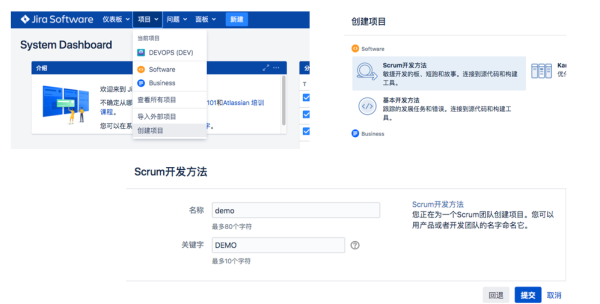
需求与代码关联:在jira中创建一个任务/故事,关联模块后自动在该模块创建一个以ISSUE(任务/故事)ID的特性分支。此时的模块等同于每个微服务的项目(代码库)名称。以下面图中为例:我们在demo项目中创建了一个模块demo-hello-service,其实对应的就是Gitlab代码库中demo组的demo-hello-service服务。
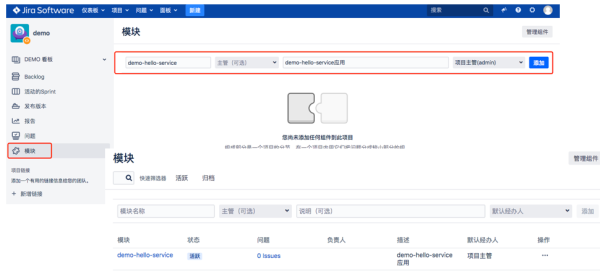
特性分支:创建好每个模块后,就可以实现需求与代码关联。例如:我们在Jira项目demo中创建一个问题,类型为故事(不受限制可为其他),重点是需要将改故事关联到模块(只有关联到模块,我们才能通过接口得知哪个问题关联的哪个代码库)。
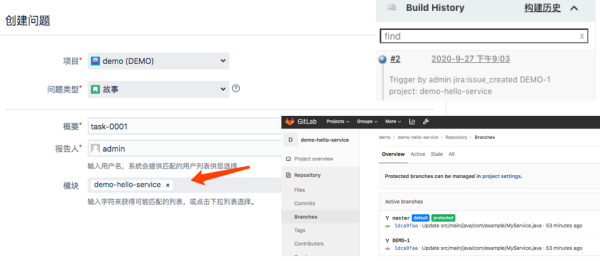
版本分支:当特性分支开发完成以及测试验证完成后,基于主干分支创建一个版本分支,然后将所有的特性分支合并到版本分支。此时可以通过Jira中创建一个发布版本,然后问题关联发布版本(此动作表示该特性分支已经通过验证,可以合并)。自动完成版本分支的创建和特性分支到版本分支的合并请求。
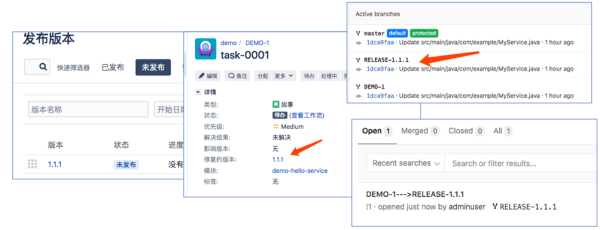
2. 配置过程
需求与代码库关联,主要用到的工具链为: Jira + GitLab + Jenkins。Jira负责创建需求,配置webhook。Jenkins负责接收Jira webhook请求,然后通过接口实现GitLab项目分支创建。
特性分支自动化:当我们在jira上面创建了问题,此时会通过Jira的webhook触发对应的Jenkins作业,该Jenkins作业通过解析Jira webhook传递的数据,找到问题名称和模块名称。调用GitlabAPI 项目查询接口,根据模块名称找到代码库。调用GitLabAPI 分支创建接口,根据问题名称基于主干分支创建一个特性分支。任务结束。
版本分支自动化:Jira创建发布版本,Issue关联版本。自动在gitlab代码库基于master创建版本分支,并开启特性分支到版本分支的合并请求。
2.1 准备工作
在Jenkins, 创建一个Pipeline 作业并配置GenericTrigger 触发器,接收JiraWebhook数据。projectKey 参数表示Jira项目名称,webHookData 参数为Jira webhook的所有数据。token 是触发器的触发token,这里默认采用的作业名称(作业名称要唯一)。
triggers { GenericTrigger( causeString: 'Trigger By Jira Server -->>>>> Generic Cause', genericRequestVariables: [[key: 'projectKey', regexpFilter: '']], genericVariables: [[defaultValue: '', key: 'webHookData', regexpFilter: '', value: '$']], printContributedVariables: true, printPostContent: true, regexpFilterExpression: '', regexpFilterText: '', silentResponse: true, token: "${JOB_NAME}" )在Jira项目中配置Webhook,勾选触发事件填写触发URL。http://jenkins.idevops.site/generic-webhook-trigger/invoke?token=demo-jira-service&projectKey=${project.key} (这个地址是jenkins Generictrigger生成的,这里不做过多的介绍)
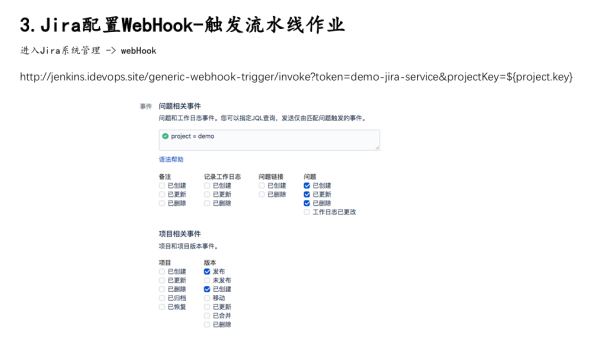
Jira webhook数据参考, 这些参数可以在Jenkinsfile中通过readJSON格式化,然后获取值。
response = readJSON text: """${webHookData}""" println(response) //获取webhook的事件类型 env.eventType = response["webhookEvent"]{ "timestamp":1603087582648, "webhookEvent":"jira:issue_created", "issue_event_type_name":"issue_created", "user":Object{...}, "issue":{ "id":"10500", "self":"http://192.168.1.200:8050/rest/api/2/issue/10500", "key":"DEMO-2", "fields":{ "issuetype":{ "self":"http://192.168.1.200:8050/rest/api/2/issuetype/10001", "id":"10001", "description":"", "iconUrl":"http://192.168.1.200:8050/images/icons/issuetypes/story.svg", "name":"故事", "subtask":false }, "components":[ { "self":"http://192.168.1.200:8050/rest/api/2/component/10200", "id":"10200", "name":"demo-hello-service", "description":"demo-hello-service应用" } ], "timespent":null, "timeoriginalestimate":null, "description":null, ... ... ...2.2 封装GitLab接口
Gitlab接口文档:https://docs.gitlab.com/ce/api/README.html
共享库:src/org/devops/gitlab.groovy
package org.devops //封装HTTP请求 def HttpReq(reqType,reqUrl,reqBody){ def gitServer = "http://gitlab.idevops.site/api/v4" withCredentials([string(credentialsId: 'gitlab-token', variable: 'gitlabToken')]) { result = httpRequest customHeaders: [[maskValue: true, name: 'PRIVATE-TOKEN', value: "${gitlabToken}"]], httpMode: reqType, contentType: "APPLICATION_JSON", consoleLogResponseBody: true, ignoreSslErrors: true, requestBody: reqBody, url: "${gitServer}/${reqUrl}" //quiet: true } return result } //更新文件内容 def UpdateRepoFile(projectId,filePath,fileContent){ apiUrl = "projects/${projectId}/repository/files/${filePath}" reqBody = """{"branch": "master","encoding":"base64", "content": "${fileContent}", "commit_message": "update a new file"}""" response = HttpReq('PUT',apiUrl,reqBody) println(response) } //获取文件内容 def GetRepoFile(projectId,filePath){ apiUrl = "projects/${projectId}/repository/files/${filePath}/raw?ref=master" response = HttpReq('GET',apiUrl,'') return response.content } //创建仓库文件 def CreateRepoFile(projectId,filePath,fileContent){ apiUrl = "projects/${projectId}/repository/files/${filePath}" reqBody = """{"branch": "master","encoding":"base64", "content": "${fileContent}", "commit_message": "create a new file"}""" response = HttpReq('POST',apiUrl,reqBody) println(response) } //更改提交状态 def ChangeCommitStatus(projectId,commitSha,status){ commitApi = "projects/${projectId}/statuses/${commitSha}?state=${status}" response = HttpReq('POST',commitApi,'') println(response) return response } //获取项目ID def GetProjectID(repoName='',projectName){ projectApi = "projects?search=${projectName}" response = HttpReq('GET',projectApi,'') def result = readJSON text: """${response.content}""" for (repo in result){ // println(repo['path_with_namespace']) if (repo['path'] == "${projectName}"){ repoId = repo['id'] println(repoId) } } return repoId } //删除分支 def DeleteBranch(projectId,branchName){ apiUrl = "/projects/${projectId}/repository/branches/${branchName}" response = HttpReq("DELETE",apiUrl,'').content println(response) } //创建分支 def CreateBranch(projectId,refBranch,newBranch){ try { branchApi = "projects/${projectId}/repository/branches?branch=${newBranch}&ref=${refBranch}" response = HttpReq("POST",branchApi,'').content branchInfo = readJSON text: """${response}""" } catch(e){ println(e) } //println(branchInfo) } //创建合并请求 def CreateMr(projectId,sourceBranch,targetBranch,title,assigneeUser=""){ try { def mrUrl = "projects/${projectId}/merge_requests" def reqBody = """{"source_branch":"${sourceBranch}", "target_branch": "${targetBranch}","title":"${title}","assignee_id":"${assigneeUser}"}""" response = HttpReq("POST",mrUrl,reqBody).content return response } catch(e){ println(e) } } //搜索分支 def SearchProjectBranches(projectId,searchKey){ def branchUrl = "projects/${projectId}/repository/branches?search=${searchKey}" response = HttpReq("GET",branchUrl,'').content def branchInfo = readJSON text: """${response}""" def branches = [:] branches[projectId] = [] if(branchInfo.size() ==0){ return branches } else { for (branch in branchInfo){ //println(branch) branches[projectId] += ["branchName":branch["name"], "commitMes":branch["commit"]["message"], "commitId":branch["commit"]["id"], "merged": branch["merged"], "createTime": branch["commit"]["created_at"]] } return branches } } //允许合并 def AcceptMr(projectId,mergeId){ def apiUrl = "projects/${projectId}/merge_requests/${mergeId}/merge" HttpReq('PUT',apiUrl,'') }2.3 共享库配置
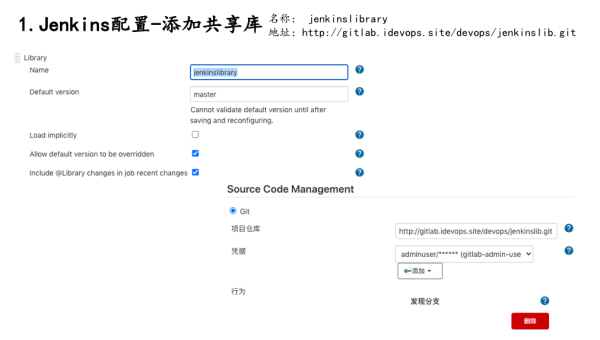
到此,关于“微服务需求与代码管理的方法是什么”的学习就结束了,希望能够解决大家的疑惑。理论与实践的搭配能更好的帮助大家学习,快去试试吧!若想继续学习更多相关知识,请继续关注亿速云网站,小编会继续努力为大家带来更多实用的文章!
免责声明:本站发布的内容(图片、视频和文字)以原创、转载和分享为主,文章观点不代表本网站立场,如果涉及侵权请联系站长邮箱:is@yisu.com进行举报,并提供相关证据,一经查实,将立刻删除涉嫌侵权内容。